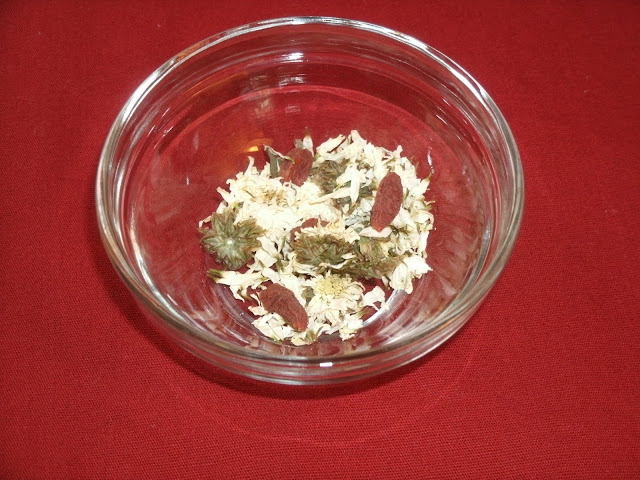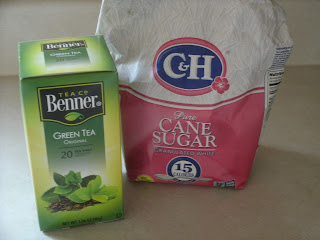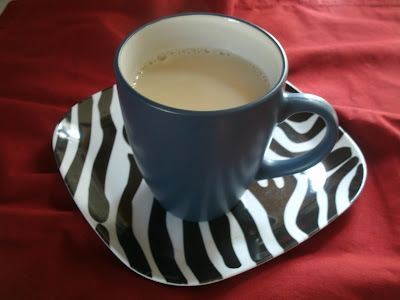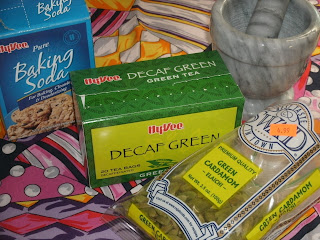Chrysanthemum tea
Chrysanthemum tea comes from traditional Chinese medicine. It is an herbal tea that is said to have cooling properties. How convenient since it is still summer. It is also said to be good for people with a quick temper, and people who are spending a lot of time studying. My interest in this tea comes from an article I read that said it is a good source of calcium. I figure my bones can use all the help they can get.
Chrysanthemums for tea come in 2 different colors. White, and yellow. From what I have read, white is the preferred color (but yellow has a less medicinal flavor). My local tea shop sells white. If you read about chrysanthemum tea online, it also cautions people who are allergic to daises not to drink it. If you have allergies to flowers, be sure to check out whether or not this would be a problem for you.
I have been experimenting with this tea for a couple of months now. When I drink it plain, I can definitely tell that it is related to daisies. I also know why nobody has ever made daisy scented perfume. It was becoming clear that we were heading for gag reflex territory by drinking it plain. Now in the defense of Chinese medicine, all of the resources I looked at talked about putting sugar into the mixture, and I'm sure that it would make it taste better. There's just that thing about me not wanting to put sugar into my beverages. So, I started to look for add ins. As luck had it, Chinese medicine says that gogi berries are good for your vision. Heaven knows that my vision could use some help (especially after squinting at the tiny text in the medical coding books all summer). I was also fortunate enough to find gogi berries at my local tea shop. Since they weren't too expensive, I got a small bag. Unfortunately, these are one of the "super foods" that people are willing to overpay for, in hopes that it will magically cure the effects of their chronically bad eating habits, but I digress...
Here they are, dried chrysanthemum flowers, and gogi berries. I wasn't sure how many berries to use (they are tiny), so I used 4. The bag had instructions for how to brew a plain cup of gogi berry tea, but I didn't want to go that far. Fortunately, both ingredients said to steep for 5 minutes in boiling water. How fortunate!
So I added my water, and waited.
and waited...
Look how pretty this looks while brewing. I'll admit that I moved things around a bit with a fork to make a nice composition in my cup. As you may also ascertain, the flowers turn to mush as they steep.
The end product still looks the same. You get a cup of bright red liquid. The berries did help the flavor of the tea. It had a slightly sweet finish, and the gaggy feeling went away. A little sweetness does help the flavor of this tea.
I will also admit that I have given it the chai treatment. While most of the spices used in chai (ginger, cinnamon, cloves, etc) are said to have a warming effect in Chinese medicine, I didn't care. It does taste better when brewed with these items.
There is a bit of a learning curve with learning to drink this tea. I have a nice, big bag of it now, so I'm sure that there will be more experimenting. At least it doesn't taste as bad as chamomile tea, so there is something to be said in its favor. I can't say that I would recommend this as a beginner tea. As an aside, I will also add that gogi berries don't taste very good on their own. They definitely do better as an accompaniment to something else.
Chrysanthemums for tea come in 2 different colors. White, and yellow. From what I have read, white is the preferred color (but yellow has a less medicinal flavor). My local tea shop sells white. If you read about chrysanthemum tea online, it also cautions people who are allergic to daises not to drink it. If you have allergies to flowers, be sure to check out whether or not this would be a problem for you.
I have been experimenting with this tea for a couple of months now. When I drink it plain, I can definitely tell that it is related to daisies. I also know why nobody has ever made daisy scented perfume. It was becoming clear that we were heading for gag reflex territory by drinking it plain. Now in the defense of Chinese medicine, all of the resources I looked at talked about putting sugar into the mixture, and I'm sure that it would make it taste better. There's just that thing about me not wanting to put sugar into my beverages. So, I started to look for add ins. As luck had it, Chinese medicine says that gogi berries are good for your vision. Heaven knows that my vision could use some help (especially after squinting at the tiny text in the medical coding books all summer). I was also fortunate enough to find gogi berries at my local tea shop. Since they weren't too expensive, I got a small bag. Unfortunately, these are one of the "super foods" that people are willing to overpay for, in hopes that it will magically cure the effects of their chronically bad eating habits, but I digress...
Here they are, dried chrysanthemum flowers, and gogi berries. I wasn't sure how many berries to use (they are tiny), so I used 4. The bag had instructions for how to brew a plain cup of gogi berry tea, but I didn't want to go that far. Fortunately, both ingredients said to steep for 5 minutes in boiling water. How fortunate!
So I added my water, and waited.
and waited...
Look how pretty this looks while brewing. I'll admit that I moved things around a bit with a fork to make a nice composition in my cup. As you may also ascertain, the flowers turn to mush as they steep.
The end product still looks the same. You get a cup of bright red liquid. The berries did help the flavor of the tea. It had a slightly sweet finish, and the gaggy feeling went away. A little sweetness does help the flavor of this tea.
I will also admit that I have given it the chai treatment. While most of the spices used in chai (ginger, cinnamon, cloves, etc) are said to have a warming effect in Chinese medicine, I didn't care. It does taste better when brewed with these items.
There is a bit of a learning curve with learning to drink this tea. I have a nice, big bag of it now, so I'm sure that there will be more experimenting. At least it doesn't taste as bad as chamomile tea, so there is something to be said in its favor. I can't say that I would recommend this as a beginner tea. As an aside, I will also add that gogi berries don't taste very good on their own. They definitely do better as an accompaniment to something else.







It looks like a cup of instant soup before you strain it.
ReplyDeleteI have seen recipes where they cook it with agar powder, and don't strain out the flowers, so I guess you could leave it in and eat it as an instant soup.
Delete